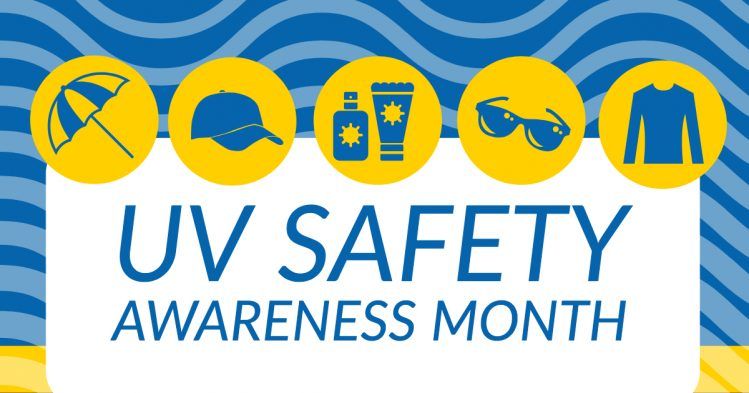
July is UV safety awareness month. During the sunny summer months, a lot of emphasis placed on protecting our skin and eyes from Ultraviolet (UV) rays. Many of us know that overexposure to UV rays from the sun during the summer months (when we are often outside for extended periods of time) can cause severe skin and eye injuries, including sunburn, skin cancer, cataracts, macular degeneration, and growths on our eyes - including cancer. In the continental U.S., the hours between 10 a.m. and 4 p.m. are the most hazardous for UV exposure and are at their greatest intensity during the late spring and early summer.
Before we explain the harmful effects of overexposure and provide tips on minimizing these effects, we should explain exactly what we are dealing with.
What are UV rays?
Ultraviolet (UV) rays are an invisible kind of radiation that comes from the sun, tanning beds, and sunlamps. UV rays can penetrate and change skin cells. There are three types of UV rays:
Ultraviolet A (UVA): UVA rays penetrate deep into the layers of the skin and lead to premature signs of aging, which include fine lines and wrinkles. It is important to note that the amount of UVA stays relatively consistent throughout the year, and exceeds the amount of UVB in both summer and winter. Even on a cloudy day, 80% of the sun's UVA rays pass through the clouds and reach our skin and eyes. It's also important to know that tanning beds work by emitting primarily UVA rays.
Ultraviolet B (UVB): UVB rays are the primary cause of sunburn, thickening of the skin, and several types of skin cancers - including melanoma. UVB rays penetrate the outermost layer of skin and cause damage to skin cells. UVB also can cause damage to eyes and the immune system.
Ultraviolet C (UVC): UVC is the strongest of the UV spectrum radiation. Fortunately, UVC rays do not reach the earth's surface because it is blocked by the ozone layer of the atmosphere. The only way we can be exposed to UVC radiation is from an artifical source, such as a lamp or laser. UVC rays can cause severe skin burns and eye injuries even when exposed for only a few seconds. Since the penetration depth of UVC rays is very low, these injuries usually resolve within a week with virtually no risk of long-term health risks (skin cancer, cateracts, vision loss).
Tips for protecting your skin against UVA and UVB overexposure
Look for three letters. SPF (Sun Protection Factor) is an essential factor when determining which sunscreen you use. SPF values measure how much a sunscreen can protect you from sunburn. For example, if you apply SPF 30 sunscreen sufficiently and evenly, it will take 30 times longer for your skin to begin to burn than if you did not wear any sunscreen protection at all. With this in mind, you should reapply sunscreen at least every two hours and after swimming, towel dry, and apply again for extended sun exposure.
Cover all your bases. Because SPF measures protection against sunburn caused primarily by UVB rays, be sure your SPF sunscreen protects against UVA rays as well by choosing products that provide both UVA and UVB protection. These lotions and sprays are usually labeled broad spectrum and are available as body and face sunscreens as well as daily moisturizers.
Be consistent. Wear or use a broad spectrum sunscreen every day to protect your skin from the harmful effects of the sun. Apply generous amounts of sunscreen, especially when you are active outdoors. Use a water-resistant sunscreen when swimming or sweating and always choose a sunscreen that offers an SPF of 30 or higher.
Ways to protect your eyes from UVA and UVB overexposure
Don't focus on color or darkness of sunglass lenses. Select sunglasses that block UV rays. Don't be deceived by color or cost. The ability to block UV light is not dependent on the price tag or how dark the sunglass lenses are.
Always look for 100 percent UV protection. Make sure your sunglasses block 100 percent of UV-A and UV-B rays.
Choose wrap-around styles. Ideally, your sunglasses should wrap all the way around to your temples so the sun can't enter from the side.
Wear a hat. In addition to your sunglasses, wear a broad-brimmed hat to protect your eyes.
Don't rely on contact lenses. Even if you wear contact lenses with UV protection, remember your sunglasses.
Don't be fooled by clouds. The sun's rays can pass through haze and thin clouds. Sun damage to eyes can occur anytime during the year, not just in the summertime.
Protect your eyes during peak sun times. Sunglasses should be worn whenever outside, and it's especially important to wear sunglasses in the early afternoon and at higher altitudes, where UV light is more intense.
Never look directly at the sun. Looking directly at the sun at any time, including during an eclipse, can lead to solar retinopathy, damage to the eye's retina from solar radiation.
Don't forget the kids. Everyone is at risk, including children. Protect their eyes with hats and sunglasses. In addition, try to keep children out of the sun between 10 a.m. and 2 p.m., when the sun's UV rays are the strongest.
